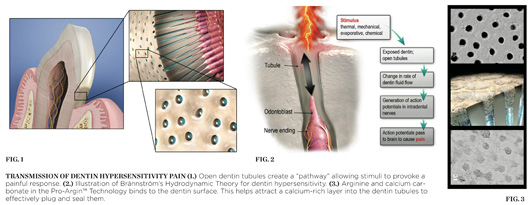Dentin Hypersensitivity
Effective treatment with the breakthrough Pro-Argin™ technology.
Resulting from any number of factors, including abrasion, gingival recession, or erosion removing the surface of tooth enamel, the dentin and dentin tubules that lie underneath enamel or cementum can become exposed (Figure 1). An external stimulus—such as a change in external temperature, air movement, or physical stimulus—can cause discomfort for the patient.
An accepted theory of how dentin hypersensitivity pain is transmitted suggests that pressure changes in the fluid inside the dentin tubules stimulate pain. This is often referred to as the “hydrodynamic theory.” A change in pressure causes a change in fluid movement, and this is transmitted to the odontoblastic process and fires the afferent nerve ending in the dentin tubule (Figure 2). Therefore, the pain caused by this change is transient—once the stimulus is removed or it dissipates, the pressure within the tubule returns to normal and the pain subsides.
Treatment and Prevention
The treatment and prevention of dentin hypersensitivity has focused on eliminating the ability of the causative agent to stimulate discomfort, resulting in the development of two major classes of products—agents that occlude dentin tubules and desensitizing agents that interfere with the transmission of nerve impulses.
Occluding agents act by physically covering the open, exposed dentin tubules, thus preventing the effect of thermal changes or physical stimuli caused by the movement of dentin fluid resulting from pressure changes. Some of these agents require professional application in the dental office, while others are incorporated in products that are used by the patient at home.
Desensitizing agents work by altering the levels of charged molecules in the dentin fluid. The most commonly used agent is potassium nitrate, usually delivered in a dentifrice that is applied by the patient during regular toothbrushing. The potassium ions must pass from the external dentin surface, through the dentin tubule, and into the pulp in order to reduce the excitation caused by the movement of fluid in the dentin tubules. Most products require continued use over a 4- to 8-week period before the patient realizes significant relief. In addition, use of the product often needs to be continued to maintain the relief afforded by the potassium ions/salts.
Pro-Argin™ Technology
Although the traditional methods of treating dentin hypersensitivity have been somewhat effective in providing relief, dental professionals continue to look for better, more effective, fast acting, and lasting treatments. In 2009, the Colgate-Palmolive Company introduced a new in-office treatment for dentin hypersensitivity called Colgate® Sensitive Pro-Relief™ desensitizing paste. Based on the Pro-Argin™ technology, it consists of arginine, a naturally occurring amino acid, and an insoluble calcium compound in the form of calcium carbonate. This technology physically seals dentin tubules with a plug that contains arginine, calcium, carbonate, and phosphate. This plug, which is resistant to normal pulpal pressures and to acid challenge, effectively reduces dentin fluid flow, and thereby reduces sensitivity (Figure 3).
Laboratory tests demonstrating the product’s mode of action, as well as clinical trials demonstrating relief of dentin hypersensitivity immediately and 4 weeks after a single application, have been published as evidence that the Pro-Argin™ technology provides instant and lasting relief of dentin hypersensitivity.
Treatment with Colgate® Sensitive Pro-Relief™ desensitizing paste is simple and easy to incorporate into everyday practice. The dental professional applies a small amount of paste to sensitive tooth surfaces with a slowly rotating, soft prophy cup. The dental professional should carefully burnish Colgate® Sensitive Pro-Relief™ desensitizing paste into all sensitive areas, focusing on the cemento-enamel junction and exposed dentin. Application results in immediate relief that lasts for 4 weeks after a single application.
Clinicians encounter patients with dentin hypersensitivity on a regular basis. While every patient is different, dentin hypersensitivity is an indication that can be managed.
For more information, contact:
Colgate-Palmolive
Phone: 800-2COLGATE
Web: www.colgateprofessional.com
E-mail: colgateprofessional.com/contact
Disclaimer
The preceding material was provided by the manufacturer. The statements and opinions contained therein are solely those of the manufacturer and not of the editors, publisher, or the Editorial Board of Inside Dentistry.







